The proposed plan envisions a new system of spaces for public enjoyment, featuring a floating garden island connected by a new water navigation system and reconfigurable roads capable of responding to people in real time. The project aims to increase the number of connections between the city and lake by overhauling the main traffic artery cutting through Lugano’s shore.
The vision addresses the disconnection between Lugano and its lake. The congested waterfront will become partly pedestrianized, with the addition of a dynamic road system which can be configured with zero, one or two lanes at different times of the day, as well as shared surfaces with playgrounds and social gathering spaces. Electric autonomous vehicles and micro-mobility solutions will integrate private mobility into the new plan. The proposed dynamic waterfront also includes a system of smart signage, responsive street furniture, infrastructure that produces clean energy from heat absorption, and a series of mobility hubs where people can select their preferred, shared mode of transport.
Lugano is committed in redesigning the front lake and the city center for the future citizens, focusing on a growing attention to dynamic public spaces, the coexistence of different mobility vectors, the development of green areas, the role of the water in city life, the impact of the landscape, and much more. The path began in 2018, when the Municipality went public with its vision and objectives, identifying innovation as one of the key points for urban development. The next step will hopefully be an open competition to create a new master plan for the city of tomorrow.
By analyzing mobile and traffic data and backing up the mobility concept’s definition with a model-based scientific approach, we supported CRA’s urban vision of transforming the fracture of today’s Lakefront vehicular axis into a responsive space, hosting new mobility solutions and enabling the waterfront to adjust dynamically to the vibrant ecosystem of Lugano.
The focus of the intervention preserves the historical value of the lakefront designed by Pasquale Lucchini in 1863, and envisions it as a transition zone between the city and the water. Among the proposed interventions, the vision plan outlines ways to physically connect Lugano and its lake, allowing the town to stretch out onto the lake thanks to a newly created floating island accessible to the public. The rotating island would be connected to the city by a series of boardwalks, and it would host a series of public spaces, including a garden to preserve the biodiversity of Lake Lugano.



